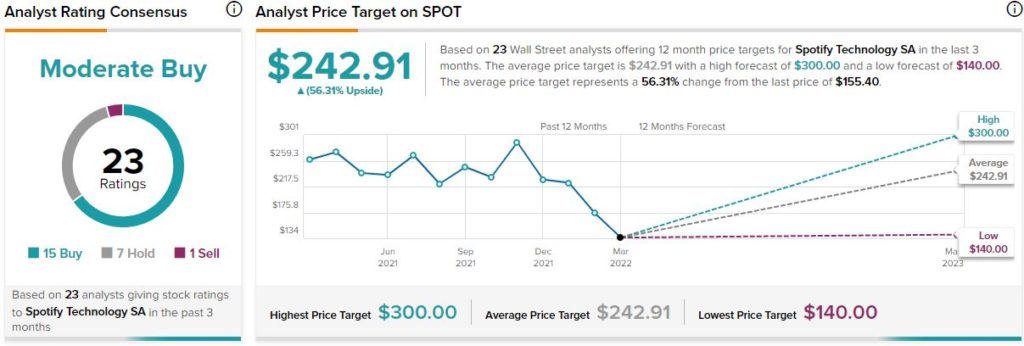Spotify Technology S.A. (SPOT) was a victim of the risk-off tech tumble, falling over 50% from the all-time high. SPOT’s fundamentals do not justify the sell-off. SPOT is edging towards profitability, which will be a major price catalyst. I am bullish because SPOT has been unfairly punished by the market’s recent downturn, while the long-term growth potential is still intact.
Maximize Your Portfolio with Data Driven Insights:
- Leverage the power of TipRanks' Smart Score, a data-driven tool to help you uncover top performing stocks and make informed investment decisions.
- Monitor your stock picks and compare them to top Wall Street Analysts' recommendations with Your Smart Portfolio
Macro Influences on the Market
SPOT can be considered a risk-on asset due to being a growth-oriented company with negative earnings. The downside of being a risk-on asset has been apparent since the sell-off started in late 2021. The result of the markets being shaken out is that you now have mispriced assets.
Growth assets that have not met earnings expectations, such as Meta (FB) or Netflix (NFLX), fell significantly. SPOT’s Q4 2021 earnings met or exceeded expectations, yet the stock has still fallen ~19% since.
The expectation of interest rates being raised to ~2.5% by the end of 2022 puts downward pressure on equities. The core reason is that as interest rates rise, higher yields can be obtained at lower risks compared to equities, leading to equities selling off. A secondary reason is if a company is holding debt or will issue debt, it will need to pay a higher rate, raising the risk of the company.
SPOT is holding €1.2 billion of debt but is holding €3.4 billion in cash and equivalents. SPOT holding enough cash to pay off the debt lowers the interest rate risk significantly. If, in the unlikely case that we see significantly heightened interest rates, SPOT will not need to re-issue debt at a higher rate.
Ultimately, SPOT will not see its fundamental risk increase due to rising interest rates. SPOT may even see an inflow of interest due to some investors divesting from leveraged companies.
To quantify the shift in market expectations, we can look at the enterprise value (EV)/sales ratio. SPOT’s EV/sales ratio has dropped significantly over the last year from ~5 to ~2.8. The drop can be attributed due to the decrease in price while sales are still rising. The takeaway is that the market is pricing SPOT’s sales at almost half the value of last year.
Stabilizing Growth
Next, we’ll look at the fundamental reasons for and against Spotify’s share decline.
The core driver of SPOT’s top line is monthly active users (MAU). SPOT saw a COVID-19 boost, accelerating its growth for 2020. Since the market effects of COVID-19 have mostly wound down, SPOT has been met with headwinds.
2020 saw 27% MAU growth, whereas 2021 saw only 18%. The significant decline in growth most likely spooked investors. If MAU growth were to continue to drop, the bearish case would be justified.
However, management expects 2022 MAU growth to be materially indifferent compared to 2021. Assuming management expectations are correct, growth stabilization will decrease the underlying risk of the company.
Despite MAU growth slowing, revenue growth still increased to 24% in 2021 from 17% in 2020. Accelerating revenue growth is a positive sign of long-term growth.
SPOT has been nearing profitability, which, if it does become profitable, will be a major plus for the bullish case. 2021 was the first year that earnings before interest or tax (EBIT) was positive.
Contract Risk
Gross profit margin has seen stagnation sitting in the 25-27% range for a few years now. This is largely due to the long-term contracts with major license holders, including Warner, Universal, and Sony. Although the specifics of the contracts are not known, it is highly likely they will be renewed in the next few years.
Since SPOT has grown significantly since the contracts were signed, it is likely they will be able to negotiate a better deal. The contract negotiations can be the make-or-break moment.
Warner has deepened relationships by going in on a podcast deal with SPOT. Whereas Universal (LSE: 0UMG) and Sony (SONY) still own 100% and 50%, respectively, of the stock they obtained from previous deals. As the three major players have relations with SPOT, it is likely to be favorable, and if not, it is very unlikely to be a catastrophe.
The bearish case is if SPOT is unable to retain significant control over the music streaming business, we could see similar issues to Netflix. Netflix shifted from the one-stop-shop of video streaming to the current multi-org situation, which has put significant pressure on subscriber numbers.
As music has fewer major content holders, SPOT is less likely to see the same shift, but it is always a risk if contract negotiations turn bad.
Wall Street’s Take
Turning to Wall Street, Spotify comes in as a Moderate Buy, with 15 Buys, seven Holds, and one Sell rating assigned over the past three months.
The average Spotify stock price target is $242.91, implying 56.3% upside potential.

Conclusion
Before the recent drop, SPOT was trading at the high-end of Wall Streets’ expectations, but the recent decline has made SPOT extremely appealing. I agree with the consensus; I believe SPOT is a Buy.
Download the TipRanks mobile app now
To find good ideas for stocks trading at attractive valuations, visit TipRanks’ Best Stocks to Buy, a newly launched tool that unites all of TipRanks’ equity insights.
Read full Disclaimer & Disclosure









